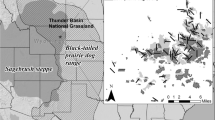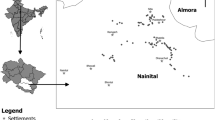Abstract
We tested the hypothesis that black-tailed prairie dogs (Cynomys ludovicianus) influence avian community structure on the shortgrass prairie. We surveyed 36 prairie dog towns and 36 paired sites without prairie dogs during summer and fall of 1997, 1998, and 1999 in the Oklahoma Panhandle. Our surveys totaled 9,040 individual observations for 73 avian species. Significantly distinct avian communities were present on prairie dog towns when compared to sites within four different macrohabitats of the surrounding landscape: open rangeland, scrub/sandsage (Artemisia filifolia) habitats, Conservation Reserve Program (CRP) plots, and fallow crop fields. Relative densities of all bird species combined was higher on prairie dog towns versus paired sites in summer and fall. Mean species richness of birds was significantly higher on prairie dog towns than paired sites during summer, but there were no significant differences in fall. Open rangeland had the highest mean species richness in fall. Assemblages of avian communities differed significantly between prairie dog towns and the four macrohabitat types during summer. Burrowing owls (Athene cunicularia), killdeer (Charadrius vociferous), horned larks (Eremophila alpestris), and meadowlarks (Sturnella spp.) were positively and significantly associated with prairie dog towns during summer, while horned larks and ferruginous hawks (Buteo regalis) were significantly associated with prairie dog towns during fall. Even in their current remnant state, black-tailed prairie dogs continue to play a significant role in the assembly of ecological communities across the Great Plains. Conservation of prairie dogs goes well beyond a single species, and is an important strategy for the preservation of the prairie ecosystem as a whole.







Similar content being viewed by others
References
Agnew WD, Uresk W, Hansen RM (1986) Flora and fauna associated with prairie dog colonies and adjacent ungrazed mixed-grass prairie in western South Dakota. J Range Manage 39:135–139
Allison PS, Leary AW, Bechard MJ (1995) Observations of wintering Ferruginous Hawks (Buteo regalis) feeding of prairie dogs (Cynomys ludovicianus) in the Texas Panhandle. Texas J Sci 47:235–237
Askins RA (1993) Population trends in grassland, shrubland, and forest birds in eastern North America. Curr Ornithol 11:1–34
Askins RA (2000) Restoring North America’s birds: lessons from landscape ecology. Yale University Press, New Haven, Conn.
Bak JM, Boykin KG, Thompson BC, Daniel DL (2001) Distribution of wintering Ferruginous Hawks (Buteo regalis) in relation to black-tailed prairie dog (Cynomys ludovicianus) colonies in southern New Mexico and northern Chihuahua. J Raptor Res 35:124–129
Barko VA, Shaw JH, Leslie DM, Jr. (1999) Birds associated with black-tailed prairie dog colonies in southern shortgrass prairie. Southwest Nat 44:484–489
Benedict RA, Freeman PW, Genoways HH (1996) Prairie legacies – Mammals. In: Samson FB, Knopf FL (eds) Prairie conservation. Island Press, Washington, D.C., pp 149–166
Bibby CJ, Burgess ND, Hill DA (1992) Bird census techniques. Academic Press, London
Blair WF, Hubbell TH (1938) The biotic districts of Oklahoma. Am Mid Nat 20:425–454
Butts KO (1976) Burrowing Owls wintering in the Oklahoma Panhandle. Auk 93:510–516
Collins SL (1992) Fire frequency and community heterogeneity in tallgrass prairie vegetation. Ecology 73:2001–2006
Desmond MJ, Savidge JA, Seibert TF (1995) Spatial patterns of Burrowing Owl (Speotyto cunicularia) nests within black-tailed prairie dog (Cynomys ludovicianus) towns. Can J Zool 73:1375–1379
Emlen JT (1971) Population densities of birds derived from transect counts. Auk 88:323–342
Emlen JT (1977 ) Estimating breeding season bird densities from transect counts. Auk 94:455–468
Goodwin HT (1995) Pliocene-Pleistocene biogeographic history of prairie dogs, genus Cynomys (Sciuridae). J Mammal 76:100–122
Hoogland JL (1995) The black-tailed prairie dog: social life of a burrowing mammal. University of Chicago Press, Chicago
Hoogland JL (1996) Cynomys ludovicianus. Mammalian Species Account No. 535. American Society of Mammalogists
Kantrud HA, Kologiski RL (1982) Effects of soils and grazing on breeding birds of uncultivated upland grasslands of the northern Great Plains. Wildlife Research Report 15. U.S. Department of the Interior, Fish and Wildlife Service, Washington, D.C.
Knopf FL (1994) Avian assemblages on altered grasslands. Studies Avian Biol 15:247–257
Knopf FL (1996a) Prairie legacies – Birds. In: Samson FB, Knopf FL (eds) Prairie conservation. Island Press, Washington, D.C., pp 135–148
Knopf FL (1996b) Mountain Plover (Charadrius montanus). In: Poole A, Gill F (eds) The Birds of North America, no. 211. The Birds of North America, Philadelphia, Pa.
Knopf FL, Samson FB (1995) Conserving the biotic integrity of the Great Plains. In: Johnson SR, Bouzaher A (eds) Conservation of Great Plains ecosystems: current science, future options. Kluwer, Boston, Mass., pp 121–133
Knowles CJ, Stoner CJ, Gieb SP (1982) Selective use of black-tailed prairie dog towns by Mountain Plovers. Condor 84:71–74
Kotliar NB (2000) Application of the new keystone-species concept to prairie dogs: how well does it work? Conserv Biol 14:1715–1721
Kotliar NB, Baker BW, Whicker AD, Plumb G (1999) A critical review of assumptions about the prairie dog as a keystone species. Environ Manage 24:177–192
Kretzer JE, Cully JF Jr (2001) Effects of black-tailed prairie dogs on reptiles and amphibians in Kansas shortgrass prairie. Southwest Nat 46:171–177
Lawton JH, Jones CG (1995) Linking species and ecosystems: organisms as ecosystem engineers. In: Jones CG, Lawton JH (eds) Linking species and ecosystems. Chapman & Hall, New York, pp 141–150
Lockwood JL, McKinney ML (eds) (2001) Biotic homogenization. Kluwer, New York
Lomolino MV, Smith, GA (2001) Dynamic biogeography of prairie dog (Cynomys ludovicianus) towns near the edge of their range. J Mammal 82:937–945
Lomolino MV, Smith GA (2004) Terrestrial vertebrate communities at black-tailed prairie dog (Cynomys ludovicianus) towns. Biol Conserv 115:89–100
Lomolino MV, Channell R, Perault DR, Smith GA (2001) Downsizing nature: anthropogenic dwarfing of species and ecosystems. In: Lockwood JL, McKinney ML (eds) Biotic homogenization. Kluwer, New York, pp 223–243
Manzano-Fischer P, List R, Ceballos G (1999) Grassland birds in prairie-dog towns in northwestern Chihuahua, Mexico. Studies Avian Biol 19:263–271
McIntyre NE (1995) Effects of forest patch size on avian diversity. Landscape Ecol 10:85–99
McPherson GR (1995) The role of fire in the desert grasslands. In: McClaran MP, Van Devender TR (eds) The desert grassland. University of Arizona Press, Tucson, pp 130–151
Mengel RM (1970) The North American central plains as an isolating agent in bird speciation. In: Dort W Jr, Jones JK Jr (eds) Pleistocene and recent environments of the central Great Plains. University Press of Kansas, Lawrence, Kan, pp 279–340
Miller B, Ceballos G, Reading R (1994) The prairie dog and biotic diversity. Conserv Biol 8:677–681
Miller B, Reading R, Hoogland J, Clark T, Ceballos G, List R, Forrest S, Hanebury L, Manzano P, Pacheco J, Uresk D (2000) The role of prairie dogs as keystone species: response to Stapp. Conserv Biol 14:318–321
Miller SD, Cully JF, Jr. (2001) Conservation of black-tailed prairie dogs (Cynomys ludovicianus). J Mammal 82:889–893
Ostlie WR, Schneider RE, Aldrich JM, Faust TM, McKim RLB, Chaplin SJ (1997) The status of biodiversity in the Great Plains. The Nature Conservancy, Arlington, Va.
Peterjohn BG, Sauer JR (1999) Population status of North American grassland birds from the North American Breeding Bird Survey, 1966–1996. Studies Avian Biol 19:27–44
Ramankutty N, Foley JA (1999) Estimating historical changes in land cover: North American croplands from 1850 to 1992. Global Ecol Biogeog 8:381–396
Reading RP, Beissinger SR, Grensten JJ, Clark TW (1989) Attributes of black-tailed prairie dog colonies in northcentral Montana, with management recommendations for the conservation of biodiversity. In: Clark TW, Hinckley D, Rich T (eds) The prairie dog ecosystem: managing for biological diversity. Montana BLM Wildlife Technical Bulletin No. 2, Bureau of Land Management, Billings, Mont., pp 13–27
Resampling Stats (1997) Resampling Stats, version 4.1b4. Arlington, Va.
Shackford JS, Tyler JD (1991) Vertebrates associated with black-tailed prairie dog colonies in Oklahoma. Report submitted to the Oklahoma Department of Wildlife Conservation, Oklahoma City
Sharps JC, Uresk DW (1990) Ecological review of black-tailed prairie dogs and associated species in western South Dakota. Great Basin Nat 50:339–345
Sidle JG, Johnson DH, Euliss BR (2001) Estimated areal extent of colonies of black-tailed prairie dogs in the northern Great Plains. J Mammal 82:928–936
Sieg CH, Flather CH, McCanny S (1999) Recent biodiversity patterns in the Great Plains: implications for restoration and management. Great Plains Res 9:277–313
Sims PL, Risser PG (2000) Grasslands. In: Barbour MG, Billings WD (eds) North American terrestrial vegetation, 2nd edn. Cambridge University Press, Cambridge, pp 324–356
SPSS (2000) SYSTAT, version 10. SPSS Science, Chicago
Thomas L, Laake JL, Derry JF, Buckland ST, Borchers DL, Anderson DR, Burnham KP, Strindberg S, Hedley SL, Burt ML, Marques FFC, Pollard JH, Fewster RM (1998) Distance 3.5. Research Unit for Wildlife Population Assessment, University of St. Andrews, UK (Available: http://www.ruwpa.st-and.ac.uk/distance/)
Tilman D, Wedin D, Knops J (1996) Productivity and sustainability influenced by biodiversity in grassland ecosystems. Nature 379:718–720
Tyler JD (1968) Distribution and vertebrate associates of the black-tailed prairie dog in Oklahoma. PhD Dissertation, University of Oklahoma, Norman
Udvardy MDF (1958) Ecological and distributional analysis of North American birds. Condor 60:50–66
Vinton MA, Collins SL (1997) Landscape gradients and habitat structure in native grasslands of the central Great Plains. In: Knopf FL, Samson FB (eds) Ecology and conservation of Great Plains vertebrates. Springer, New York Berlin Heidelberg, pp 3–19
Wallace LL, Turner MG, Romme WH, O’Neill RV, Wu Y (1995) Scale of heterogeneity of forage production and winter foraging by elk and bison. Landscape Ecol 10:75–83
Weltzin JF, Dowhower SL, Heitschmidt RK (1997) Prairie dog effects on plant community structure in southern mixed-grass prairie. Southwest Nat 42:251–258
Whicker AD, Detling JK (1988) Ecological consequences of prairie dog disturbances. Bioscience 38:778–785
Winter SL, Cully JF, Jr., Pontius JS (1999a) Influence of prairie dog colonies and climatic variation on bird communities in Kansas shortgrass prairie. In: Thorpe J, Steeves TA, Gollop M (eds) Proceedings of the fifth prairie conservation and endangered species conference. Provincial Museum of Alberta, Edmonton, Alberta, p 374
Winter SL, Cully JF, Jr., Pontius JS (1999b) Influence of prairie dogs on vegetation in Kansas shortgrass prairie. In: Thorpe J., Steeves TA, Gollop M (eds) Proceedings of the fifth prairie conservation and endangered species conference. Provincial Museum of Alberta, Edmonton, Alberta, pp 375–379
Wuerthner G (1997) Viewpoint: the black-tailed prairie dog—headed for extinction? J Range Manage 50:459–466
Acknowledgments
R. Channell, T.A. Franklin, E. Johnson, M. Le, J. Moodie, R. Ramirez, and D. Vu helped with field surveys. I. Butler, R. Channell, T.A. Franklin, D. Hough, E. Johnson, D. Perault, and D. Vu provided assistance with various aspects of data entry and analysis. M. Kaspari, W. Matthews, D. Perault, D. Simberloff, and two anonymous reviewers provided helpful comments on previous drafts of this manuscript. We thank D. Musick of the U.S. Forest Service and L. Green, M. Crocker, N. Erdman, and D. Watson of the Oklahoma Department of Wildlife Conservation for providing access to federal and state lands and for assistance finding possible sites to survey. We sincerely appreciate the many private landowners that allowed us to conduct surveys on their property. We are grateful to the University of Oklahoma, Department of Zoology, and the Oklahoma Biological Survey for access to resources and vehicles. This research was funded by a National Science Foundation (NSF) grant (DEB-9622137), two Research Experience for Undergraduates (REU) supplements from NSF (DEB-9820439, and DEB-9942014), and two faculty enrichment grants from the College of Arts and Sciences of the University of Oklahoma to M.V. Lomolino, and a George Miksch Sutton Scholarship in Ornithology and grants from the Department of Zoology and Graduate Student Senate of the University of Oklahoma to G.A. Smith. This work was submitted by GAS in partial fulfillment of the requirements for a doctoral degree in the Department of Zoology at the University of Oklahoma.
Author information
Authors and Affiliations
Corresponding author
Rights and permissions
About this article
Cite this article
Smith, G.A., Lomolino, M.V. Black-tailed prairie dogs and the structure of avian communities on the shortgrass plains. Oecologia 138, 592–602 (2004). https://doi.org/10.1007/s00442-003-1465-3
Received:
Accepted:
Published:
Issue Date:
DOI: https://doi.org/10.1007/s00442-003-1465-3




